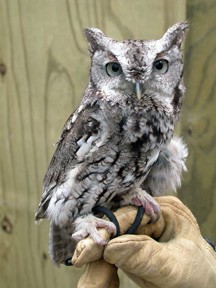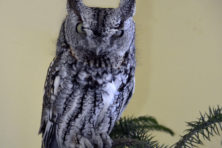Screech Owl: Feathered Wildcat
- Share
- Tweet
- Pin
- Share
If you were a child of 10 or 12, playing a game of softball with friends at home during your summer vacation, and suddenly in your neighbor’s nearby huge Horse Chestnut tree a dozen or more robins, generally concealed from view within the huge tree crown, began screaming their heads off as though every feather on their bodies was being individually pulled out, what thoughts would be going through your head?
That was the exact scenario at my home in Kewaunee dating back to around mid-summer of 1940. Naturally we boys immediately wanted to know what was causing the blood-curdling ruckus. As it turned out, the robins were having a fit over a tiny Screech Owl huddled next to the large Chestnut trunk. Within a minute or so the little owl escaped the mob, flew toward the northwest of our home where much better hiding places existed, and eventually the robins gave up the chase. However, it being my very first sighting of one these beautiful owls, my interest in them has continued to grow during the ensuing 70-plus years.

Wood carving done by Roy’s Great Uncle Paul Wodsedalek in 1910.
Actually my first real interest in these petite owls began about 1936 or so when my two older brothers and I would go down the hill to play at Grandpa and Grandma Lukes’ home. A lovely handmade knick-knack shelf having three or four different levels hung on the wall in their living room and on the fixture sat five or six hand-carved birds, meticulously made in 1910 out of Basswood by Grandpa’s cousin Paul Wodsedalek, a farmer. Grandma would bring down the carvings for us boys to play with, but only if we promised to be extra careful in handling them. The only one I own today happens to be my favorite, what appears to be a Screech Owl.
It was during my first three years of teaching, 1955-1958, at the Shorewood Hills Elementary School near Madison that I learned how useful bird-song records could be in my units about birds. Owl songs, ranging from that of the Great Horned down to the diminutive Screech and Saw-whet Owls, were among the class favorites. Every now and then a student would arrive at school in the morning with the glowing report of hearing a Screech Owl near their home the previous night, the lovely downward-slurring, horse-like whiney song being easy to identify.
It was this past Feb. 2 that Charlotte received a call from a lady living near the north end of Little Sister Road telling of watching a Screech Owl perched on a lower branch of a conifer tree outside one of their windows. Earlier her husband had been doing some snow blowing not too far from the owl and that didn’t appear to affect the bird. Later as the lady watched the owl it suddenly fell off the branch and onto the snow. Later in the day the owl died and she collected it, wrapped it and put it into their freezer until the following day when she delivered it to our home. It was a red phase Screech Owl, which we have delivered to our friend, Tom Erdman, who manages the UWGB Cofrin Center for Biodiversity’s large bird skin and egg collection. These valuable skins and eggs are used for teaching and scientific research.
“Reds” can’t stand extreme heat or cold, due to an enzyme, so you won’t find them up near Lake Superior or in the Gulf States; there you’ll find mostly the gray phase. Reds have a lower survival rate during unusually cold winters, as we are experiencing now. Add deep snow to that and you can expect a very high mortality of regional Screech Owls.
Indeed, this has been a devastatingly hard winter on scores of wildlife, from small to large. It will make for fascinating observing of the many affected wildlife species, and how slowly or rapidly their populations return to normal.

A hand-held gray phase Eastern Screech Owl showing its small size.
These priceless little wonders designed for darkness enjoy a large selection of food including: songbirds, small mammals, earthworms, insects, crayfish, tadpoles, frogs, lizards, rats, mice, squirrels, chipmunks, grouse, doves, shorebirds and even woodpeckers. It is thought that, to a large extent, these “feathered wildcats” neither hunt nor eat during the daytime.
As you might suspect, they have impeccable hearing with their ears being so wide apart for such a small animal. With one of their ear openings being slightly different than the other (typical in owls), this provides them with excellent so-called triangulation therefore enabling them to pinpoint the precise location and the distance their prey is to their front. Now they can aim for the kill with great accuracy even during extremely dark nighttime conditions.
They have what is referred to as zygodactyl feet, with two needle-sharp toes facing to the front and two to the rear. There are times while perching when three toes will be facing forward and one to the rear.
With the owls’ primary flight feathers being so close to their ears, nature has provided the leading edges of the wings with stiff fringes, which virtually eliminate flight noise, and in so doing, do not interfere with the birds’ impeccable and vital sense of hearing. It’s while in flight that these birds must be able to detect the very faintest of sounds. Their ears are probably as useful, or more so, at night as are its eyes. By the way, the Screech Owl’s two feather tufts on top of its head have nothing to do with its hearing. Its ears are located on the side of the head.

A gray phase Eastern Screech Owl displays its excellent camouflage plumage at the entrance to its roosting cavity.
It’s in roughly the northern third of our state where Screech Owls are rather uncommon. Very few are reported in northern Door County while a small number have been detected in Southern Door as is indicated in the Atlas of the Breeding Birds of Wisconsin. Sadly, the population of these amazing little owls, whose voice is a pleasant eerie down-slurring tremolo, has been decreasing far too rapidly in recent years. Unquestionably people are the primary cause in that they want their woods to be very clean with no dead standing timber, which these owls use for their much needed nesting cavities.
In the case that you may wish to know if your area supports Screech Owls, use a small hand-held tape player with a recording of a Screech Owl. Play it (judiciously) especially in various wooded habitats early in the evening and in the early hours before sunrise. Ever since this easy technique has been used, several surprisingly large counts of the owls have been tallied. For example, 106 were reported on the 1987 Christmas Bird Count in Madison, Wis.
Please “give a hoot” and do all you can to help maintain healthy populations of these incredibly valuable owls that add their lovely tremulous voices to the nocturnal concert.


